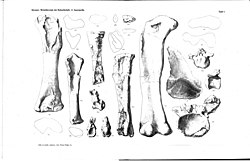Aegyptosaurus
| Aegyptosaurus Temporal range: Cenomanian,
~ | |
|---|---|

| |
| Humerus and femur reconstructions (from specimen 1912VIII61) to scale | |
| Scientific classification | |
| Domain: | Eukaryota |
| Kingdom: | Animalia |
| Phylum: | Chordata |
| Clade: | Dinosauria |
| Clade: | Saurischia |
| Clade: | †Sauropodomorpha |
| Clade: | †Sauropoda |
| Clade: | †Macronaria |
| Clade: | †Titanosauria |
| Genus: | †Aegyptosaurus Stromer, 1932 |
| Type species | |
| †Aegyptosaurus baharijensis Stromer, 1932
| |
Aegyptosaurus /iːˌdʒɪptoʊˈsɔːrəs/ (meaning 'Egypt's lizard') is a genus of sauropod dinosaur that lived in what is now Africa, around 95 million years ago, during the Late Cretaceous Period (Cenomanian faunal stage).
Discovery and naming
The holotype (1912VIII61) consists of three caudal vertebrae, a partial scapula, and some limb bones, all of which were discovered in the Bahariya Formation of Egypt between 1910 and c. 1913 by Ernst Stromer and Richard Markgraf[1] and the holotype was sent to Munich, Germany in 1915 to be studied at the same time the holotype of Spinosaurus aegyptiacus was described.[2]

Aegyptosaurus was described by German paleontologist Ernst Stromer in 1932, seventeen years after the holotype was sent to Munich,[1] and its fossils have been found in the Bahariya Formation of Egypt, the Farak Formation of Niger and in several other different locations in the Sahara Desert.[3] The generic name, Aegyptosaurus, is derived from the country in which it was discovered and the Greek sauros meaning 'lizard'. All of the specimens destroyed in 1944 were discovered before 1939 and the fossils were stored together in Munich, but were obliterated when an Allied bombing raid destroyed the museum where they were kept on 25 April 1944, during World War II. Only fragments from other specimens still exist, mostly in the form of indeterminate specimens from Egypt and Niger.[4][5][6]

de Lapparent (1960) referred a series of caudal vertebrae from the Continental intercalaire of Egypt to Aegyptosaurus baharijensis.[4]
Description
In 2010, based on Paralititan and other related titanosaurs, Gregory S. Paul estimated the length of Aegyptosaurus at 15 metres (49 ft), and its weight at 7 tonnes (7.7 short tons).[7]
Text is available under the CC BY-SA 4.0 license; additional terms may apply.
Images, videos and audio are available under their respective licenses.












